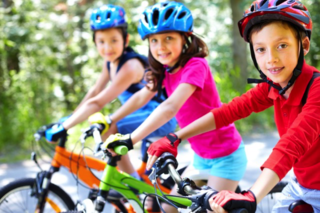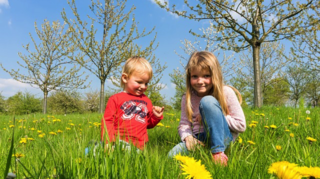Image Source
Anything happening to our children is a parent’s worst nightmare, bar none. Even the thought can keep us up at night. But when we’re out and about in public places, there’s a multitude of risks that our little ones face. There are, however, measures we can take to keep them safe. Whether it’s about teaching them their emergency contact number, or buying the right equipment to ensure they’re protected, here are some ways to help to ensure your little ones are safe.
In the park
If you’ve ever tried to keep track of more than one child in an expansive public place, you’ll know the challenges. They seem to be able to zip off at a moment’s notice, and somehow end up 50 feet away with no warning. The park is open to strangers, animals, and other dangers, which can make a trip to the park quite anxiety-inducing for any parent or carer.
Firstly, keep them safe from injury. The park is usually full of all manner of equipment, but these pieces of equipment were created with different age groups in mind. Encouraging your children to only play on pieces which were created with their age group in mind will help to reduce the likelihood of injury, or them getting stuck at a height – which you typically have to climb up to to help them down. When you arrive at the park, give the equipment a quick once over. Check that it is sturdy, installed properly, and that it isn’t obviously damaged in any way. It’s also worth doing a quick scout of the ground too, checking for sharp objects and broken glass, as well as any dirt or dog excrement – you’d much prefer to find it before the games begin, then you children find it later on. Never leave your children unattended when playing on park equipment – the risk of fall, a banged head, or worse are too high to risk it.
Try only to go to play parks in enclosed areas. This tends to help keep pet dogs at bay, who may only come over out of inquisitiveness, but could startle children. It also helps to avoid them running away and hiding while your back is turned. There is obviously the concern of Stranger Danger in parks. Be sure to discuss this with your youngsters as soon as they’re old enough to understand. If they know to avoid people that they don’t know, and never to follow a stranger, their safety is improved. Be vigilant when you’re in the park – keep an eye out for people who look suspicious, warn other parents nearby and, if you think it’s necessary, be sure to contact your local police department. Stranger danger is no small matter, and vigilance must be maintained.
Image Source
In a crowd
It’s so easily to get separated accidentally from your loved ones in a crowd. Many parents feel very nervous while walking through a crowded space with their young children, as it is so easy to lose sight of them. It isn’t possible to always avoid crowds at events or the mall, but it is possible to make your children safer.
If you’re attending an event which you expect will be busy, there are a few things you can do. At the start of the day take a photo on your cell phone of your child – this will be useful when forming a search if you do end up being separated. It’s also a good idea to write your cell phone number on your child’s wrist, covering it with a liquid band aid to stop the ink from being rubbed off, and telling them to show that to an authority figure if they can’t find you. It’s always worth agreeing on a meeting point when you arrive at a venue, so that if you do become separated your child knows where to ask a member of staff to take them to to be reunited with you.
There are also exercises you can do with your children before an event, so they know what to do if you get separated. For example, as soon as they’re old enough to memorize numbers, teach them your cell number by heart – you could even make it into a little song to help to aid their memory. A good game to help them to recognize authority figures is to play the “who works here?” game when you’re out and about. Ask them to pick out police officers, shop assistants, lifeguards, security officers, and help them to recognize identifying features. That way, if you ever do get separated, they’re comfortable working out who to approach for help.

In the car
If you’ve ever driven a newborn baby home from the hospital, you’ll know at that point you will never speed, brake hard, or take chances on intersections ever again. Driving with your child in the car can be terrifying, but obviously you can’t take responsibility for how other road users behave. You can, however, ensure that everything within your vehicle is as safe as possible for them.
Start with the car seat – any child under around the age of 12 should be in a car seat – a baby seat for small children, and a booster seat as they get a bit older. This ensures they are held properly in place if any collision does occur, but it also helps to keep them comfortable on the journey, and allows them to see out of the window. Choosing the right baby seat for your car can be tricky, but using a review website such as https://babyseats.reviews/ can help you to find one which works for you and your vehicle within your price range. Once you own the seat, it’s also essential it’s installed properly. Not only does a poorly installed car seat not properly protect your child in the event of an accident, but it can also even put them in more danger.
Having a conversation with your children about the importance of good behavior in the car is also important as soon as they understand. It should be explained that they should never distract the driver during a journey, as this could mean they miss something important on the road. It’s also crucial to teach them not to throw things around the car, as objects can find their way into the driver’s area, and even get stuck under pedals, which can potentially cause accidents. Talk to them about the importance of their seatbelt, but also lead by example. If they always see you wearing your belt, they’ll be far more likely to follow suit.

By the road
Walking down the sidewalk, crossing through traffic, or cycling along the road are all activities fraught with their own dangers. Teaching your child about behaving properly by the road is crucial to avoid accidents. Crossing at proper crossing points is something that can be taught at a young age, and you can lead by example and be a great role model too. If you do need to cross a road which doesn’t have a crossing, be sure to demonstrate the safest means to cross, and never cross between two parked vehicles. It’s also important to demonstrate the safe way to walk by the road. Youngsters should always walk on the size away from the traffic, and it’s essential that they walk, and never run. Running by the road can be really dangerous, especially for small children who have a tendency to fall. It’s far easier to teach good habits than to break bad habits, so leading by example is definitely the way to go.
Keeping your children safe while you’re out and about is about equal part preparation, education, and vigilance.



